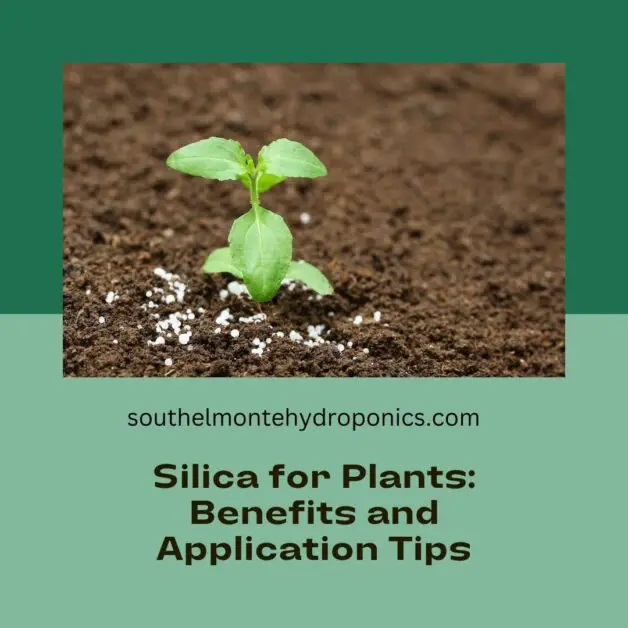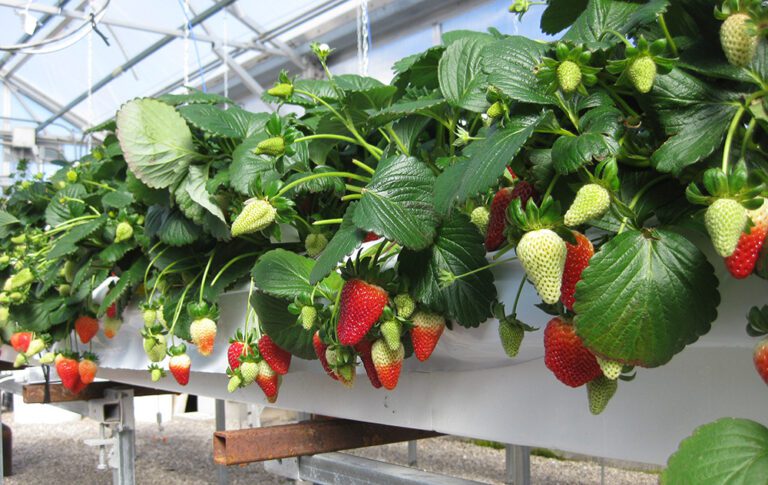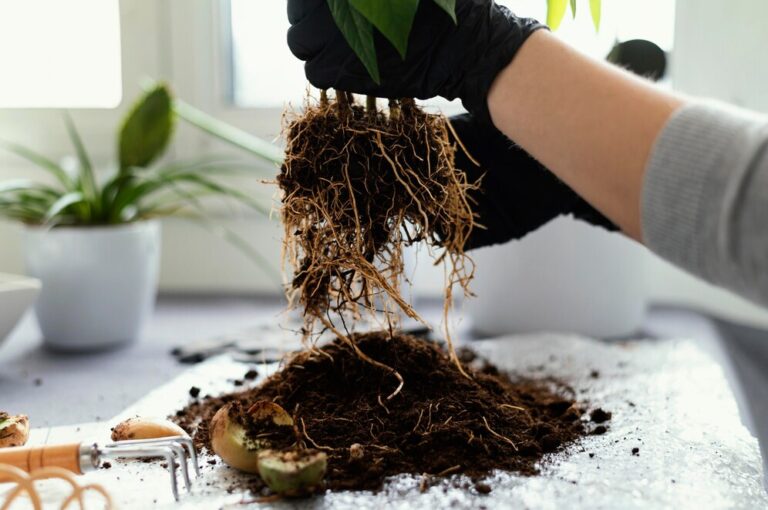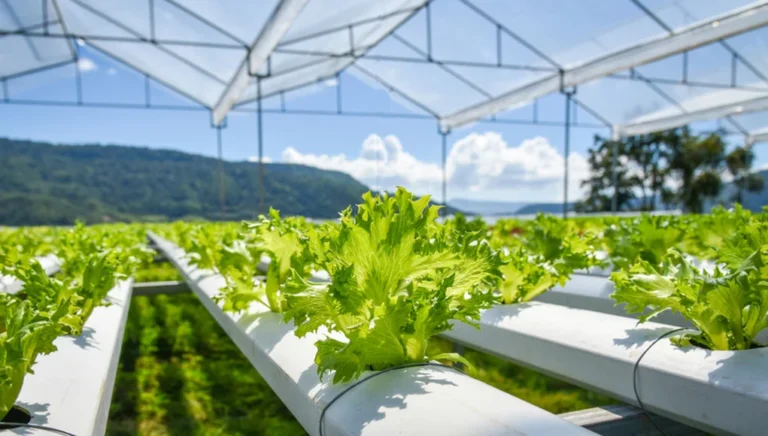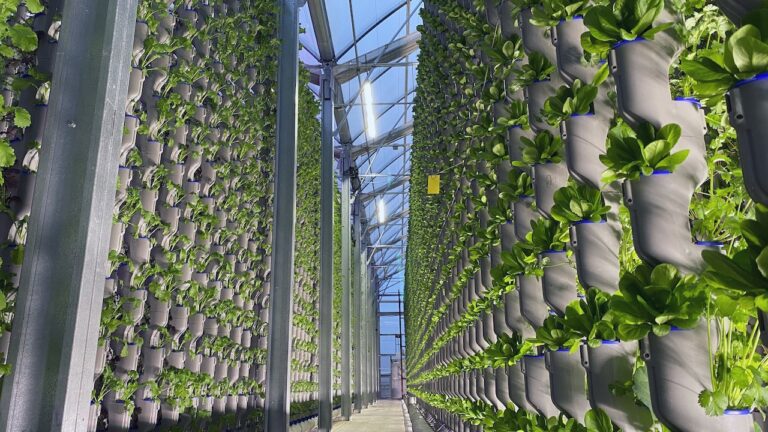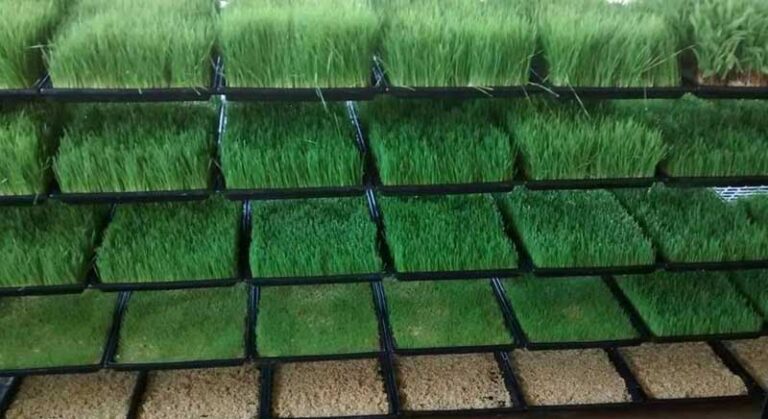Best Silica for Plants: What It Is, Why It Matters, and How to Use It
Table of Contents
Best Silica for Plants: The Importance of Silica in Plant Growth

Best Silica for Plants: Silica, also known as silicon dioxide, is an essential trace element for plant growth. While it may not be as widely recognized as other nutrients like nitrogen, phosphorus, and potassium, silica plays a crucial role in enhancing plant health and development. It is involved in various physiological processes that contribute to greater plant vigor, structure, and strength.
One of the primary benefits of silica is its ability to fortify cell walls, providing plants with structural integrity. With stronger cell walls, plants are better equipped to withstand environmental stressors such as drought, high temperatures, and strong winds. Additionally, silica promotes upright growth, preventing plants from becoming floppy or prone to lodging. This not only enhances the aesthetic appeal of plants but also ensures that valuable fruits, flowers, or crops stay upright and accessible for harvest.
Furthermore, Best Silica for Plants has been found to stimulate the natural defense mechanisms of plants, making them more resistant to pests, diseases, and pathogens. This is due to silica’s capacity to reinforce the physical and chemical barriers that protect plants from external threats. By forming a physical barrier on the plant’s surface, silica impedes the entry of pests and pathogens, reducing the risk of infestations and infections. Additionally, silica can also prompt the production of antimicrobial compounds within the plant, further enhancing its disease resistance.
As we delve deeper into the importance of silica in plant growth, we will explore the factors affecting silica availability in soils and the different sources of silica for plants. We’ll also discuss how to determine the optimal silica levels for different plant species and the methods of effectively applying silica to plants. Additionally, we’ll address common challenges in silica application and provide practical solutions for overcoming them. So, stay tuned to unleash the full potential of silica in promoting healthy and vibrant plants.
Understanding the Role of Best Silica for Plants health
Silica is a crucial element for the overall health and development of plants. It plays a vital role in enhancing plant structure and strength, as well as in promoting disease resistance. Understanding the role of silica in plant health is essential for any gardener or plant enthusiast.
When Best Silica for Plants comes to plant structure, silica acts as a building block, strengthening cell walls and improving overall plant rigidity. This is especially important for plants that are exposed to environmental stressors such as wind or heavy rainfall. By incorporating silica into their cell walls, plants become more resilient and better equipped to withstand these external forces.
Additionally, silica plays a crucial role in promoting disease resistance in plants. It acts as a physical barrier, making it harder for pathogens to invade and infect plant tissues. This is particularly important in maintaining the health of plants, as it helps prevent the spread of fungal diseases and other harmful pathogens. Furthermore, silica has been shown to stimulate the plant’s own defense mechanisms, making it more capable of fighting off infections.
Understanding the benefits of silica for plant health can help gardeners and plant enthusiasts take the necessary steps to provide their plants with optimal conditions for growth. From enhancing plant structure and strength to promoting disease resistance, silica plays a crucial role in ensuring healthy and thriving plants. By incorporating silica into plant care routines, using silica-rich soil amendments or foliar sprays, and monitoring silica levels in plants, gardeners can maximize the benefits of this essential element and create a more resilient and flourishing plant environment. So, let’s dive deeper into the various factors affecting silica availability in soils and explore different sources of silica for plants.
Exploring the Benefits of Best Silica for Plants
Silica, also known as silicon dioxide, is a crucial element for the health and vitality of plants. It plays an important role in plant structure and strength, as well as in disease resistance. Silica is found naturally in soils, but its availability can be influenced by various factors such as soil pH, temperature, and moisture levels. Understanding the benefits of silica for plants can help gardeners and plant enthusiasts make informed decisions to optimize plant growth and overall health.
One of the key benefits of silica for plants is its ability to enhance plant structure and strength. Silica deposits within the plant’s cell walls, forming a rigid lattice-like structure that provides stability and support. This strengthened structure helps plants withstand environmental stressors such as wind, drought, and pest attacks. Additionally, plants with sufficient silica levels have been found to have thicker cell walls, which can deter plant-eating insects and grazing animals. By incorporating silica into their plant care routine, gardeners can promote stronger, healthier plants that are more resistant to physical damage.
Another advantage of Best Silica for Plants is its positive impact on disease resistance. Research has shown that silica can act as a natural defense mechanism against various fungal and bacterial pathogens. When silica is present in plants, it forms a physical barrier, making it more difficult for pathogens to penetrate and invade plant tissues. This can minimize the risk of diseases such as powdery mildew, leaf spot, and gray mold. Furthermore, silica has been found to stimulate the plant’s natural defense mechanisms, such as the production of enzymes and antimicrobial compounds. This proactive defense system can help plants effectively fight off diseases, leading to healthier and more resilient plants.
While silica is naturally present in many soils, the availability of silica to plants can vary depending on factors such as soil composition and pH. In some cases, soils may be deficient in silica, leading to inadequate plant uptake. This deficiency can manifest as weak plant structures, reduced disease resistance, and decreased overall vigor. In such situations, it may be necessary to supplement silica using external sources. There are various commercial products available that contain high levels of plant-available silica, such as potassium silicate. These products can be applied as foliar sprays, root drenches, or incorporated into the growing medium. Regular monitoring of silica levels in plants and adjusting the application rates accordingly can help ensure that plants receive the optimal levels of silica for their specific needs.
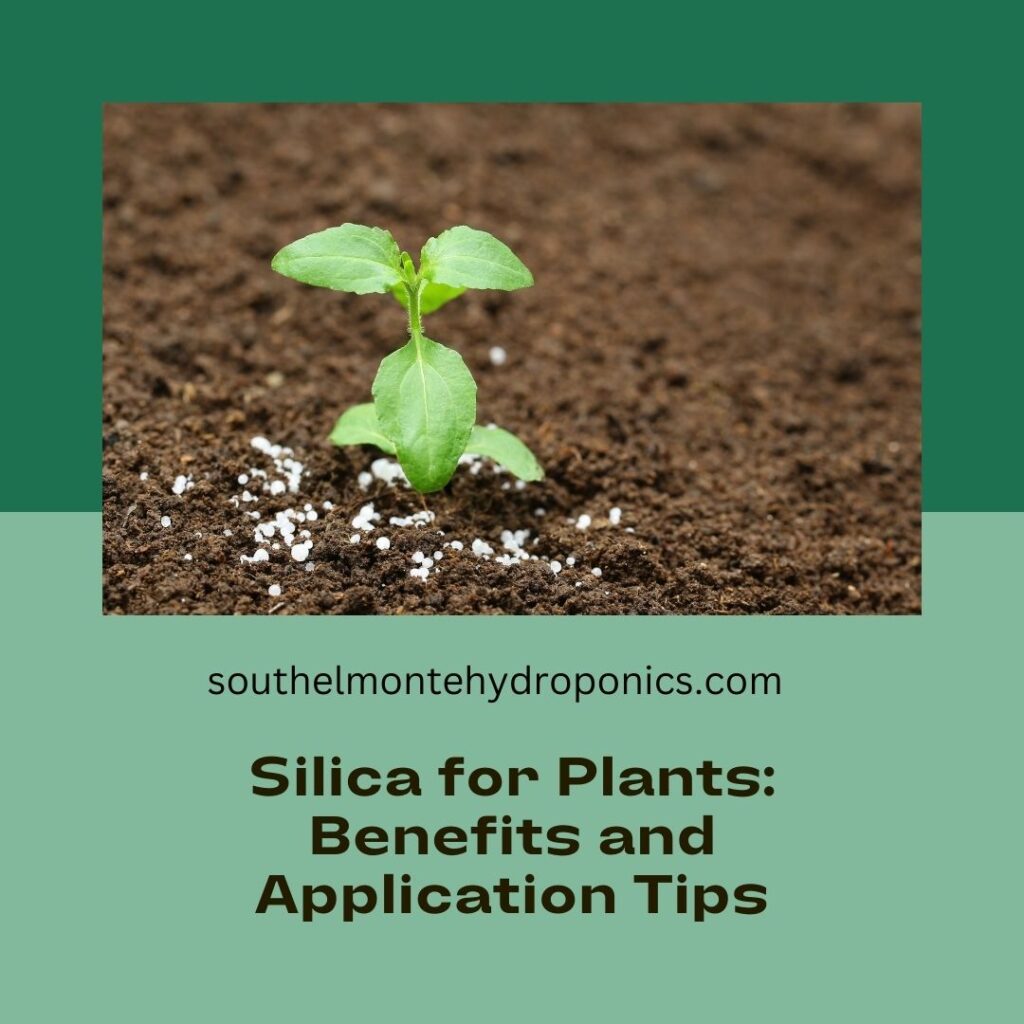
Here’s a table highlighting some of the Best Silica for Plants, considering factors such as purity, ease of use, and effectiveness:
| Product Name | Type | Silica Content | Formulation | Additional Features | Application Frequency | Price Range |
|---|---|---|---|---|---|---|
| Silica Blast by Botanicare | Liquid | 0.2% | Silicic Acid (potassium silicate) | Highly concentrated, promotes plant strength and resilience. | Weekly to Bi-weekly | $20 – $40 per quart |
| Pro-TeKt by Dyna-Gro | Liquid | 3.0% | Potassium Silicate | Improves plant structure, helps with nutrient uptake. | Every 1-2 weeks | $15 – $30 per quart |
| Silica Power by GreenPlanet Nutrients | Liquid | 4.0% | Potassium Silicate | Enhances plant cell walls, increases resistance to stress. | Bi-weekly | $20 – $40 per liter |
| Monterey AgSil 16.5% Liquid Silicate | Liquid | 16.5% | Potassium Silicate | OMRI listed, suitable for organic gardening. | Every 2-4 weeks | $20 – $40 per quart |
| Raw Silica by NPK Industries | Powder | 45.8% | Potassium Silicate | High concentration, compatible with various growing mediums. | Bi-weekly | $20 – $40 per pound |
| Armor Si by General Hydroponics | Liquid | 0.4% | Silicic Acid (potassium silicate) | Enhances plant structure, improves resistance to environmental stress. | Weekly to Bi-weekly | $20 – $40 per quart |
Note: Prices may vary based on location and retailer for Best Silica for Plants.
When choosing a Best Silica for Plants, consider factors such as the specific needs of your plants, application convenience, and your preferred form (liquid or powder). Always follow the recommended application rates and guidelines provided by the manufacturer for optimal results.

How Best Silica for Plants Structure and Strength
Best Silica for Plants, also known as silicon dioxide, is an essential element for the growth and development of plants. It plays a crucial role in enhancing plant structure and strength. Silica is absorbed by plants in the form of monosilicic acid, which is then utilized to form silicon cells within the plant’s tissues. These silicon cells provide support and rigidity to the plant, making it more resistant to environmental stressors such as wind, pests, and diseases.
One of the key ways in which silica enhances plant structure is by promoting the deposition of lignin in the cell walls. Lignin is a complex organic compound that gives rigidity and strength to plant tissues. With an adequate supply of silica, plants are able to produce more lignin, resulting in thicker and sturdier cell walls. This, in turn, leads to improved plant structure and the ability to withstand physical pressure and maintain an upright posture.
Additionally, silica also influences the formation of silicified structures called phytoliths. Phytoliths are microscopic structures composed of amorphous silica that are deposited in various plant tissues, such as leaves, stems, and roots. These phytoliths act as a reinforcement system, strengthening the overall plant structure. They can also act as barriers, preventing the spread of pathogens within the plant.
In conclusion, silica plays a crucial role in enhancing plant structure and strength. It promotes the deposition of lignin, leading to thicker and stronger cell walls. It also influences the formation of phytoliths, which provide additional support and defense against environmental stressors. By understanding the importance of silica in plant growth, we can harness its benefits to cultivate healthier and more robust plants.
The Relationship Between Best Silica for Plants and Disease Resistance in Plants
Silica, often overlooked in discussions of plant health, plays a crucial role in enhancing disease resistance in plants. When it comes to plant health, the focus is often on providing adequate nutrients and water. However, the presence of silica in plants is equally important for their overall well-being. Silica acts as a natural defense mechanism, forming a protective barrier against various diseases and pathogens that can harm plants.
The relationship between Best Silica for Plants and disease resistance in plants can be attributed to several key factors. First and foremost, silica reinforces plant cell walls, making them stronger and more resistant to invasive pathogens. Additionally, the presence of silica in plant tissues triggers the production of phytoalexins, which are natural compounds that help fend off harmful microorganisms. This dual action of silica not only fortifies the physical structure of plants but also activates their immune responses, effectively reducing the risk of disease.
But how exactly do plants obtain silica? The Best Silica for Plants is abundantly present in many soils, albeit in insoluble forms. However, certain environmental factors can affect its availability for plant uptake. Low pH, excessive soil moisture, and high levels of phosphorous and aluminum can hinder silica availability to plants. To ensure optimal silica uptake, it is crucial to maintain proper soil conditions and pH levels. Furthermore, incorporating organic matter into the soil can enhance silica availability by facilitating its conversion into soluble forms that plants can readily absorb.
Enhancing disease resistance in plants through silica application is a practical and sustainable approach for plant care. There are several methods available to apply silica to plants, such as foliar sprays, soil amendments, and hydroponic solutions. Each method has its advantages and considerations, depending on the specific plant species and growing conditions. Furthermore, choosing the right silica product is essential to ensure its effectiveness. Some products may contain impurities or lack the necessary bioavailability for plants. Therefore, it is advisable to select high-quality silica products from reputable manufacturers or suppliers.
By understanding the relationship between Best Silica for Plants and disease resistance in plants, gardeners and plant enthusiasts can take proactive measures to support their plants’ health. Incorporating silica into their plant care routine can not only strengthen the plant’s structure but also provide a robust defense against diseases and pathogens. As a result, plants can flourish, displaying enhanced growth and vitality. With the right knowledge and practices, harnessing the benefits of silica can contribute to a thriving and resilient plant ecosystem.
Factors Affecting Silica Availability in Soils: Best Silica for Plants

Silica, also known as silicon dioxide, is an essential mineral for plant growth and development. Its availability in soils can vary and is influenced by several factors. One of the main factors affecting silica availability in soils is the soil pH. Silica is most soluble and readily available to plants in neutral to slightly acidic soils. In alkaline soils, however, the availability of silica decreases significantly, making it harder for plants to absorb and utilize this vital nutrient.
Another factor that affects silica availability in soils is soil texture. Silica tends to be more available in sandy soils compared to clayey soils. This is because silica particles are smaller in sandy soils, allowing for easier absorption by plant roots. In contrast, clay particles bind tightly to silica, making it less accessible to plants.
It’s important to note that silica availability can also be influenced by the presence of other elements in the soil. For example, high levels of aluminum and iron can compete with silica for uptake by plants, reducing its availability. On the other hand, certain nutrients like potassium and calcium can enhance silica uptake by plants.
Understanding these factors is crucial for optimizing silica availability in soils. By taking measures to adjust soil pH, improve soil texture, and provide a balanced nutrient environment, gardeners and plant cultivators can ensure that plants have sufficient access to silica. This, in turn, promotes healthier plant growth, enhanced structure and strength, and increased resistance to diseases and pests. In the next section, we will explore different sources of silica for plants and how to determine the optimal silica levels for various plant species.
Different Sources of Best Silica for Plants
Silica is an essential nutrient for plants, providing numerous benefits for their growth and overall health. While silica occurs naturally in soil, there are different sources of silica that can be utilized to ensure optimal levels in plants.
One common source of silica is diatomaceous earth, which is made up of the fossilized remains of diatoms – small, single-celled algae. Diatomaceous earth is rich in silica and is often used as an organic soil amendment. It improves soil structure, enhances water retention, and helps to prevent compaction. Additionally, it has the added benefit of deterring pests such as slugs and snails.
Another source of silica for plants is potassium silicate. This soluble form of silica can be easily absorbed by plant roots and quickly utilized. Potassium silicate not only provides silica to plants but also supplies them with potassium, which is an essential macronutrient for their growth. It is commonly used in hydroponic systems, where plants are grown in nutrient-rich water solutions. The availability of silica in these systems is crucial, as it promotes the development of robust root systems and strengthens plant cell walls.
Determining the Optimal Levels for The Best Silica for Plants Species
Silica, also known as silicon dioxide, is an essential element for the growth and development of plants. It plays a crucial role in enhancing plant structure and strength, as well as increasing resistance to pests and diseases. However, determining the optimal silica levels for different plant species can be a challenging task.
The optimal silica levels for plants vary depending on various factors such as the plant species, growth stage, and environmental conditions. While some plants require higher silica concentrations to thrive, others may have lower requirements. It is important to understand the specific needs of each plant species in order to provide them with the appropriate levels of silica.
To determine the optimal silica levels for different plant species, it is recommended to conduct soil and plant tissue analysis. Soil analysis helps assess the availability of silica in the growing medium, while plant tissue analysis provides insights into the actual uptake and accumulation of silica by plants. By analyzing the results of these tests, gardeners and cultivators can determine the current silica levels in their plants and make informed decisions regarding supplementation.
It is worth noting that excessive amounts of silica can be detrimental to plants. High levels of silica can lead to nutrient imbalances and inhibit the uptake of other essential elements. Therefore, it is crucial to strike a balance and ensure that the silica levels are within the optimal range for each plant species.
Meeting the optimal silica levels for different plant species is a key factor in maximizing their growth, health, and productivity. By understanding the specific requirements of each plant and implementing appropriate supplementation strategies, gardeners and cultivators can harness the benefits of silica to promote the overall well-being of their plants. In the next section, we will explore various methods of applying silica to plants and discuss their pros and cons. Stay tuned!
Methods of Applying The Best Silica for Plants
Applying silica to plants is a critical step in enhancing their overall health and productivity. There are several methods available for effectively delivering silica to plants, each with its own benefits and considerations. The choice of method depends on factors such as the type of plants being grown, the growing medium, and the specific goals of the gardener or cultivator.
One common method of applying silica to plants is through foliar spraying. This involves diluting a silica solution and spraying it directly onto the leaves of the plants. Foliar spraying allows for quick absorption of silica through the leaf surface, promoting strong and healthy plant growth. It is particularly useful in situations where the soil lacks available silica or when rapid improvement is desired. However, it is important to note that foliar spraying should be done carefully, following the instructions provided by the silica product manufacturer, to avoid any potential harm to the plants.
Another method of applying silica to plants is through root drenching or irrigation. This involves adding a silica solution to the water used for watering the plants’ roots. By watering the plants with silica-enriched water, the silica is gradually absorbed by the roots and transported to the plant cells, contributing to their overall structure and strength. This method is most effective when the silica solution is applied consistently over time, allowing for gradual and steady uptake by the plant’s roots.
The Best Silica for Plants is worth noting that silica can also be added to the soil as a natural amendment. This is often done by incorporating silica-rich materials, such as diatomaceous earth or silica sand, into the soil during the preparation or amendment process. The silica is released slowly into the soil as it naturally breaks down, providing a long-term source of this essential nutrient for the plants.
In conclusion, there are multiple methods available for applying silica to plants, including foliar spraying, root drenching, and soil amendment. Each method offers its own advantages and considerations, so it is important to choose the one that aligns with the specific needs and goals of your plants. Whichever method you choose, regular and consistent application of silica will help promote healthy plant growth, enhance structure and strength, and improve overall plant health.
The Best Silica for Plants with soil
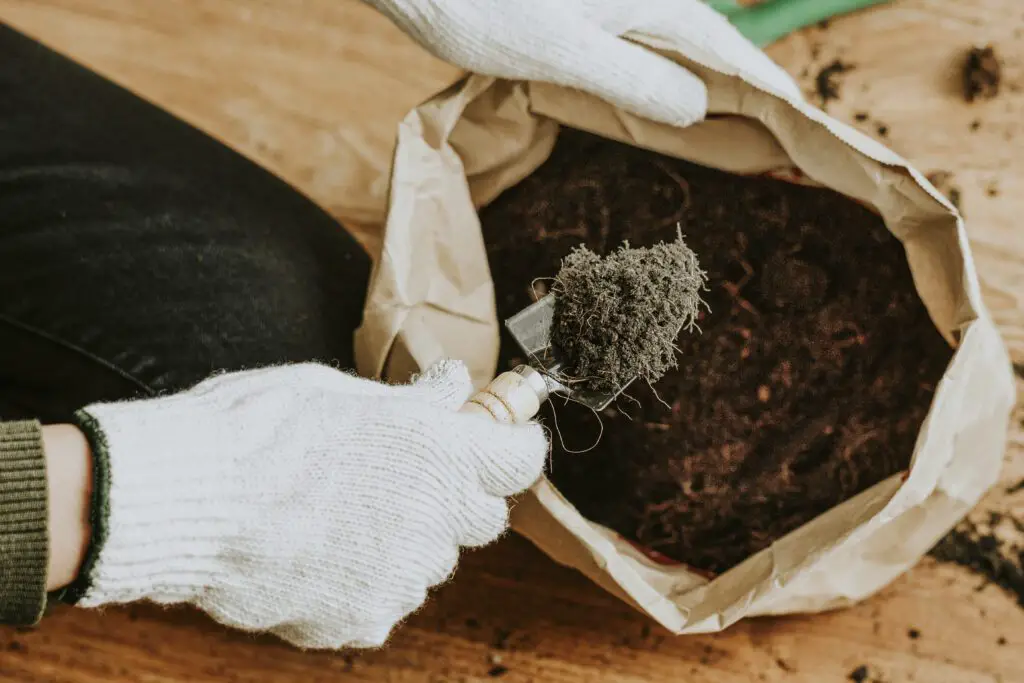
The Effects of Silica on Plant Nutrient Uptake
Silica, a commonly overlooked mineral in plant nutrition, plays a crucial role in enhancing plant nutrient uptake. While it is not classified as an essential element, the presence of silica can significantly improve the overall health and vigor of plants. Silica acts as a catalyst for metabolic processes within plants, enabling them to better absorb and utilize essential nutrients.
One key benefit of silica is its ability to enhance cation exchange capacity (CEC) in soil. CEC refers to a soil’s ability to retain and release essential nutrients for plant uptake. By increasing CEC, silica improves the soil’s capacity to retain nutrients such as potassium, calcium, and magnesium, making them readily available to plant roots. This ultimately enhances the efficiency of nutrient absorption and utilization by plants, leading to healthier and more productive crops.
In addition to improving nutrient availability, silica also promotes root development. The presence of silica in the soil stimulates root growth, enabling plants to explore a larger volume of soil and absorb a greater amount of nutrients. As a result, plants become more efficient in nutrient acquisition, leading to improved growth and yield. Furthermore, the increased root mass enhances the plant’s ability to uptake water, reducing the risk of drought stress.
Overcoming Common Challenges in Silica Application
Silica application in gardening and plant cultivation can offer a range of benefits, including enhanced plant structure, increased disease resistance, and improved nutrient uptake. However, there are common challenges that gardeners may encounter when applying silica to their plants. One common challenge is determining the optimal silica levels for different plant species. Since not all plants require the same amount of silica, it is important to understand the specific needs of each plant to achieve optimal results.
Another challenge is finding the right method of applying silica to plants. There are various methods available, such as foliar spraying, drenching the soil, or incorporating silica into the growth medium. Each method has its own pros and cons, and it is crucial to choose the most suitable approach based on the plant’s characteristics and growth stage.
To overcome these challenges, it is advisable to consult with experts in the field or refer to reputable resources that provide detailed guidelines on silica application. Conducting thorough research on the specific plant species can also help in determining the recommended silica levels and the most effective application method. Additionally, regularly monitoring the silica levels in plants through soil and tissue testing can provide valuable insights and allow for adjustments to be made as needed.
By understanding and addressing these common challenges, gardeners and plant enthusiasts can maximize the benefits of silica application and promote healthier and more vibrant plant growth.
Monitoring Silica Levels in Plants
Monitoring silica levels in plants is an important aspect of plant care, as it allows gardeners and cultivators to ensure that their plants are receiving the optimal amount of silica for healthy growth and development. Silica plays a vital role in plant health, contributing to plant structure, strength, and disease resistance. By regularly monitoring silica levels, gardeners can make informed decisions about the application of silica-based products and adjust their plant care routine accordingly.
One common method of monitoring silica levels in plants is through leaf tissue analysis. This involves collecting tissue samples from the plant and sending them to a laboratory for analysis. This analysis provides valuable information about the plant’s silica levels, allowing gardeners to determine if any adjustments need to be made to their silica supplementation. Leaf tissue analysis is particularly useful for identifying silica deficiencies in plants, as it provides a clear snapshot of the overall health and nutrient content of the plant.
Another method of monitoring silica levels is through soil testing. Soil testing can give gardeners an indication of the availability of silica in the soil, which can directly impact the plant’s ability to absorb and utilize silica. By regularly testing the soil, gardeners can ensure that the silica levels are within the optimal range for plant growth. Soil testing can also provide insights into factors that may be affecting silica availability, such as pH levels or the presence of other nutrients. By addressing these factors, gardeners can create an environment that promotes the efficient uptake and utilization of silica by plants.
In conclusion, monitoring silica levels in plants is an essential practice for any gardener or cultivator. Through leaf tissue analysis and soil testing, gardeners can gain valuable insights into the silica status of their plants and make informed decisions about silica supplementation. By ensuring that plants are receiving the optimal amount of silica, gardeners can promote healthy growth, enhance plant structure and strength, and improve disease resistance.
Maximizing the Efficiency of Silica Uptake by Plants
Maximizing the efficiency of silica uptake by plants is essential for optimizing plant growth and health. Silica, also known as silicon dioxide, plays a crucial role in promoting plant structure, strength, and disease resistance. However, not all plants have the same capacity to absorb silica, and certain factors can hinder its uptake. In this section, we will explore practical strategies to enhance the absorption of silica by plants, ensuring they receive maximum benefits from this valuable nutrient.
One effective method for maximizing silica uptake is through soil amendments. Incorporating silica-rich materials into the soil can enhance the availability of this nutrient to plants. For example, adding finely ground silica sand or diatomaceous earth to the soil can provide a slow-release source of silica. These materials gradually release silica particles that can be taken up by the plant roots over time. Additionally, using silica-based fertilizers specifically formulated for plant uptake can ensure a targeted supply of silica to meet the plants’ needs.
Another approach to enhance silica uptake is through foliar application. This method involves spraying a diluted silica solution directly onto the leaves of plants. Foliar application enables rapid absorption of silica through the stomata, small pores on the leaf surface. However, it’s important to note that not all plant species are suitable for foliar application, and it is necessary to follow proper dilution rates and application timings to avoid leaf burn or other negative effects. Regular application of silica in a foliar form can help to overcome any limitations in silica uptake through the roots, providing plants with a supplemental source of this essential nutrient.
By implementing these strategies, plant enthusiasts and gardeners can significantly improve the efficiency of silica uptake by plants. Whether through soil amendments or foliar application, maximizing silica absorption can lead to enhanced plant structure, improved disease resistance, and overall healthier plants. Stay tuned for the next section, where we will delve into the effects of silica on plant nutrient uptake and explore methods to overcome common challenges in silica application.
Silica as a Natural Pest and Disease Control for Plants
Silica, often overlooked as a pest and disease control for plants, can actually play a crucial role in protecting your garden from harmful invaders. By incorporating silica into your plant care routine, you can boost your plants’ natural defense mechanisms and promote overall plant health.
One of the key benefits of using silica as a natural pest and disease control is its ability to strengthen plant cell walls, creating a physical barrier against pests and pathogens. When plants have an ample supply of silica, their cell walls become thicker and harder, making it more difficult for insects and disease-causing organisms to penetrate and invade the plant’s tissues. This added protection can significantly decrease the risk of infestations and infections, helping your plants thrive.
Additionally, silica has been found to stimulate the production of phytoalexins, which are chemical compounds that plants naturally produce in response to stress and attack. These phytoalexins act as powerful deterrents to pests and diseases, further bolstering your plants’ defense systems. With a steady supply of silica, your plants will be better equipped to fend off threats and ward off potential problems.
But how exactly can you incorporate silica into your plant care routine? There are various methods available, such as foliar sprays, root drenches, and soil amendments. Some gardeners prefer using commercial silica products that are specifically formulated for plant use, while others opt for more natural sources like diatomaceous earth or volcanic rock dust. Regardless of the method you choose, it’s important to ensure that you follow the recommended application rates and frequency, as too much silica can cause imbalances in nutrient uptake.
By harnessing the power of silica as a natural pest and disease control, you can create an environment where your plants can thrive, free from the constraints of infestations and infections. So why not give your plants the extra protection they need and integrate silica into your plant care routine? The benefits will surely be worth the effort and investment.
Integrating Silica into a Sustainable Plant Care Routine
Integrating silica into a sustainable plant care routine is a wise decision for any gardener or plant enthusiast. Silica, also known as silicon dioxide, plays a crucial role in enhancing plant health and growth. It is abundantly found in nature, and when utilized correctly, can provide numerous benefits to your plants.
One of the key advantages of incorporating silica into your plant care routine is its ability to strengthen plant structures. When plants receive an adequate supply of silica, it is deposited within their cell walls, enhancing their rigidity and resistance to physical stressors. This can be particularly beneficial for plants that are prone to lodging or bending under the weight of heavy fruits or during strong winds.
Moreover, silica is closely associated with disease resistance in plants. It forms a protective barrier on the plant’s surface, making it more difficult for pathogens to penetrate and attack the plant. By incorporating silica into your plant care routine, you can effectively enhance your plants’ natural defense mechanisms and reduce the risk of diseases such as powdery mildew and fungal infections.
While silica is naturally present in many soils, there are factors that can affect its availability to plants. Soil pH, for instance, plays a significant role in the solubility and accessibility of silica. Acidic soils tend to restrict silica uptake, while alkaline soils facilitate its absorption. Additionally, the presence of excess phosphorus and certain heavy metals in the soil can hinder silica uptake by plants. Therefore, it is crucial to assess the pH and nutrient levels of your soil before implementing a silica application strategy.
Integrating silica into a sustainable plant care routine can be achieved through various methods. In soil-based gardening, the use of silica-rich supplements or mineral amendments can be highly effective. These supplements typically contain concentrated forms of silica, allowing for convenient and precise application. Alternatively, for hydroponic or soilless gardening systems, liquid silica nutrients can be applied directly to the plant’s root zone through watering or nutrient solution reservoirs. This method ensures optimal silica uptake by the plants, resulting in improved health and growth.
In conclusion, integrating silica into a sustainable plant care routine can greatly benefit your plants’ overall health and resilience. By strengthening plant structures and enhancing disease resistance, silica offers an effective and natural solution for maintaining vibrant and thriving plants. The availability of different silica sources and application methods allows for a flexible and customizable approach, suiting the needs of various gardening systems and plant species.
What is silica and why is it important for plant growth?
Silica is a naturally occurring compound found in soil, rocks, and plants. It plays a vital role in plant growth by enhancing their structure and strength, increasing disease resistance, and improving nutrient uptake.
How does silica enhance plant structure and strength?
Silica deposits in plant cell walls, forming a strengthening matrix that provides rigidity and support to the plant. This helps the plants withstand physical stress, such as strong winds, and improves their overall structural integrity.
Can silica help plants resist diseases?
Yes, silica plays a significant role in increasing disease resistance in plants. It forms a physical barrier against pathogens, making it more difficult for diseases to penetrate plant tissues. Additionally, silica activates the plant’s defense mechanisms, leading to a stronger immune response against diseases.
What factors affect the availability of silica in soils?
Several factors can influence the availability of silica in soils, including soil pH, temperature, moisture levels, and the presence of other minerals. Acidic soils and waterlogged conditions can reduce silica availability, while neutral to alkaline soils promote its absorption by plants.
What are the different sources of silica for plants?
Silica can be obtained by plants from various sources, including natural sources (such as volcanic ash and diatomaceous earth), agricultural by-products (such as rice husk ash), and commercially available silica supplements specifically designed for plant care.
How can I determine the optimal silica levels for different plant species?
Optimal silica levels can vary depending on the plant species. It is best to consult plant care guides or seek advice from gardening experts who can provide specific recommendations for the plants you are cultivating.
What are the methods of applying silica to plants?
Silica can be applied to plants through foliar sprays, root drenches, soil amendments, and hydroponic nutrient solutions. The method of application may vary depending on the plant’s growth stage and the desired results.
Can silica improve nutrient uptake in plants?
Yes, silica enhances the plant’s ability to absorb and utilize nutrients from the soil. It improves the efficiency of nutrient uptake by increasing root growth, surface area, and root hair density, allowing plants to access essential nutrients more effectively.
How can I monitor silica levels in my plants?
Silica levels can be monitored by conducting soil tests or plant tissue analysis. These tests can provide insights into the plant’s silica content and help adjust the silica supplementation accordingly.
How can I maximize the efficiency of silica uptake by plants?
To maximize silica uptake, it is crucial to maintain optimal growing conditions for plants, including providing adequate sunlight, proper irrigation, and appropriate nutrient levels. Additionally, ensuring a balanced pH level in the soil promotes better silica absorption.
Can silica be used as a natural pest and disease control for plants?
Yes, silica acts as a natural pest and disease control for plants. It forms a physical barrier against pests and reduces the chances of fungal and bacterial infections. Silica also stimulates the production of defense compounds in plants, further enhancing their ability to ward off pests and diseases.
How can I integrate silica into a sustainable plant care routine?
To integrate silica into a sustainable plant care routine, start by determining the silica requirements of your specific plant species. Choose a reliable source of silica and follow recommended application methods. Regularly monitor silica levels and adjust supplementation accordingly. By doing so, you can ensure optimal plant growth, disease resistance, and overall plant health in an environmentally friendly and sustainable manner.

